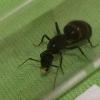https://www.tapatalk...tes-t14305.html
in this thread frogger1 details his use of a predatory mite species 'Amblyseius cucumeris'
he reports on the results of the initial release of the mites into the setup and the aftermath
after limited success with Amblyseius cucumeris, my speculation as to why being that they do not eat much, he tries Hypoaspis geolaelaps
to my understanding, this is a species previously thought to be relared to Hypoaspis miles, which is modernly classified as Stratiolaelaps scimitus
i am unsure though. something to understand is that mites are still fairly unknown in terms of biology, even more so than ants.
reading on, it seems the Hypoaspis mites did not help either
someone suggests sending one of the dead ants to a university or college to get the parasitic mites identified
this strikes me as a much better solution to identification than attempting to identify parasitic mites ourselves
there are some reports of literally wiping off mites but i would take this with a grain of salt
many species of mites like to hitch rides on ants but are completely harmless
if a mite is parasitic i would think it would be a lot harder to get off, as the ant would do it themselves if they could and wanted to
talk of the mites dying of old age is also ill informed
usually it is only one stage of development in the mites which is parasitic
mites do not live long at all, but it does not matter
they reproduce so fast and the eggs are so resilient, that is how the plague starts in the first place and it is why it is so hard to get rid of them
the thread ends there, with total uncertainty
my personal analysis is that the type of parasitic mite which is chosen for the setup must be quite important. it is possible that in the case of antscanada, the mites worked because they were mites which had been proven to travel on other insects and feed off of other mites. using the correct species is important, and i am hoping i will be able to discover more species than just Stratiolaelaps scimitus which are helpful to ant keeping
also to prove whether or not Stratiolaelaps scimitus is helpful in the first place
Edited by P0rcelain, December 11 2019 - 1:47 PM.




















